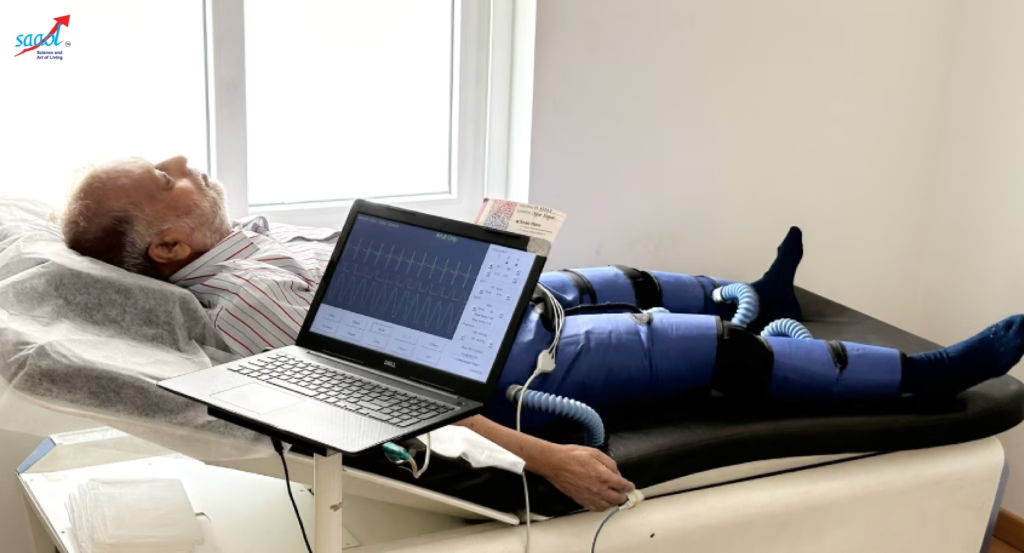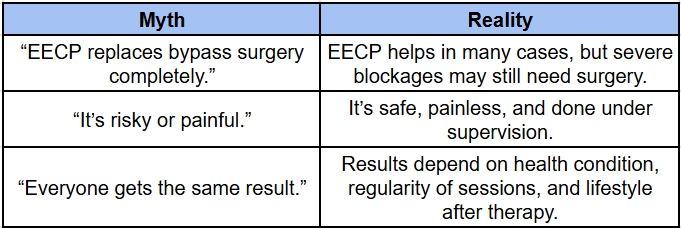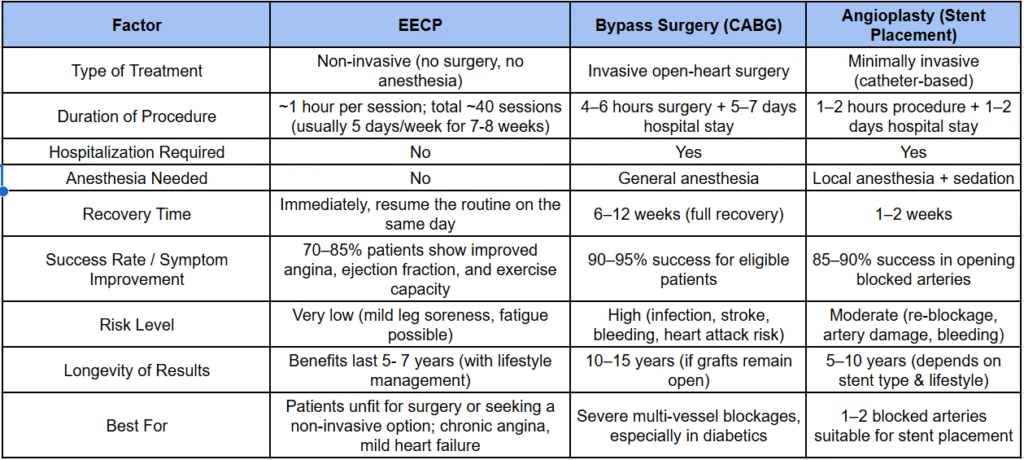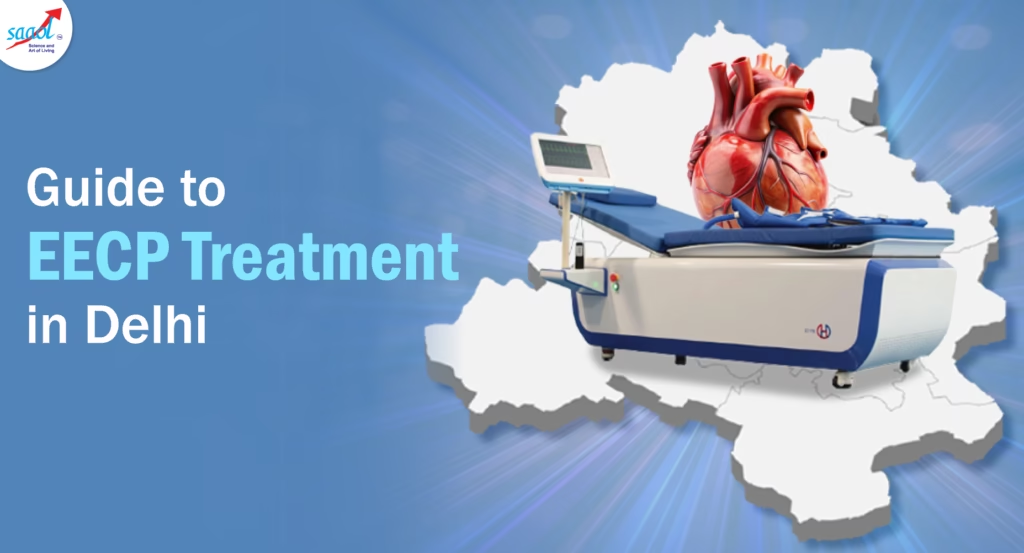When doctors start talking to heart patients about bypass surgery or stents, they often get anxious. When Dinesh Dagar was informed that his heart’s efficiency to pump had slid down to 20%, his world collapsed. There were suggestions for an urgent angiography and perhaps a bypass surgery. He and his family were terrified; they couldn’t imagine open-heart surgery. That’s natural; surgery appears to be risky, expensive, and life-changing
Then, a friend recommended him to get another opinion from SAAOL Heartcare. More people today are turning to safe, non-surgical methods of heart strengthening. Skeptical but hopeful, Dinesh began his EECP sessions. Within weeks, his chest pain eased, his energy returned, and his fear of surgery faded. Today, his heart function has improved, all without bypass or angioplasty.
If you or a loved one has angina, blocked arteries, or heart failure, you may have heard about a treatment called Enhanced External Counterpulsation (EECP), sometimes called “natural bypass.”
But what exactly is EECP treatment, how does it work, and how much does EECP treatment cost in Delhi, and above all, is it effective at all?
This blog will give you a clear, simple explanation without medical jargon so you can make the right decision for your heart health.
Table of Contents
ToggleWhy Patients Look for EECP
People mostly look for EECP when:
- Medications are not enough to relieve the chest pain.
- They are either too old or too sick for surgery.
- They are looking for a non-invasive treatment that promotes the recovery of the heart.
Dr. Vishal Sharma, COO, Senior Heart Specialist, SAAOL Heartcare Delhi, says:
“EECP gives the heart a second chance; it restores natural blood flow without surgical risk. Patients often have increased energy and less chest pain within weeks.”
What is EECP Treatment? (EECP Full Form in Medical Terms)
EECP stands for Enhanced External Counterpulsation.
EECP is a non-invasive treatment, which means no cuts, no surgery, and no anesthesia for heart conditions such as chronic angina and heart failure.
How Does EECP Work?

Here’s how it works, step by step:
- You lie on a comfortable bed in the therapy room.
- Leg cuffs inflate during the heart’s rest phase (diastole).
- This inflation pushes oxygen-rich blood back towards your heart.
- Over time, the heart generates new small vessels, a “natural bypass.”
- Each takes about an hour, and most people require 40 sessions over a few weeks.
Since it’s a non-invasive treatment, there’s no hospital stay, and you can go home after each session.
Who Can Benefit from EECP?
EECP can help:
- Patients suffering from chronic stable angina that is not completely controlled by medications.
- Patients with heart failure or low ejection fraction (heart pumping function).
- Individuals who are not fit for surgery or prefer non-invasive options.
Your doctor will review your reports and fitness level before starting your treatment.
According to Dr. Bimal Chhajer, Founder of SAAOL Heartcare Delhi
“EECP is not a replacement for bypass in all patients, but it’s a godsend to those who can’t undergo surgery. It gives relief, improves stamina, and supports recovery.”
Who should not take EECP Treatment?
1. Severe Peripheral Artery Disease (PAD):
If blood flow to your legs is already compromised, the pressure from the inflated leg cuffs can aggravate pain or harm tissues.
2. Aortic Aneurysm:
The elevated pressure that exists during EECP may cause the aorta to swell, particularly if there is already a weak spot, known as an aneurysm, in the artery wall.
3. Severe Valve Diseases (especially Aortic Regurgitation):
EECP may increase the backward flow of blood in such cases.
4. Uncontrolled High Blood Pressure (>180/110 mmHg):
EECP raises blood pressure, and it might be dangerous if BP is already at a very high level.
5. Severe Arrhythmias (Irregular or Rapid Heart Rhythms):
The machine operates in time with your heartbeat; if your rhythm is irregular, it may be unsafe or ineffective.
6. Pregnancy:
The safety of EECP during pregnancy has not been studied and is generally contraindicated.
7. Severe Leg or Skin Problems (Ulcers, Varicose Veins, Infection):
The leg cuffs could worsen existing wounds or cause discomfort.
8. Recent Major Surgery:
Particularly, in abdominal, thoracic, and vascular surgery, EECP should be deferred until complete recovery.
Benefits of EECP – What Studies Show
Clinical evidence supports EECP as an effective, safe therapy. Let’s see the benefits of EECP Treatment:
- 85% of patients experience relief from angina or an increase in exercise capacity, according to the Journal of Cardiovascular and Thoracic Research
- An 83% survival rate at 2 years after therapy, according to the American Journal of Cardiology
- Most report better sleep, more energy, and less breathlessness.
- Because it’s non-invasive, there’s no recovery downtime or major risk.
- A 2016 meta-analysis suggests that EECP has the potential to decrease hospitalization and improve the quality of life for chronic heart sufferers.
EECP Treatment Myths vs. Realities

Understanding these facts can help you manage expectations and incorporate EECP as part of a broader heart-care plan.
EECP vs. Bypass vs. Angioplasty: A Complete Comparison

EECP Treatment Cost in Delhi (and India)
Now, if you want to know the cost of EECP treatment in Delhi, then it goes roughly 1,00,000/- for a full course of therapy. In contrast, bypass surgery can range between ₹2.5 and ₹5 lakhs, while the costs of angioplasty can be between ₹1.5 and ₹ 3 lakhs, depending on the number of stents used. This makes EECP a much more cost-effective, non-surgical treatment alternative for patients who want to address angina or heart failure, where surgery represents a last resort.
Factors Affecting EECP Treatment Cost:
- Number of sessions prescribed
- Clinic or hospital reputation
- Diagnostic tests included
- Partial insurance in some cases
How to Choose the Right EECP Center in Delhi
When selecting an EECP center in Delhi:
- Find the best cardiologists with years of experience and EECP accreditation.
- Make sure they use FDA-approved EECP machines.
- Inquire about success rates and patient outcomes.
- Have support with complete monitoring and ECG during sessions.
- Read genuine reviews or testimonials.
What to Expect During Treatment
Each EECP session:
- Lasts around 1 hour.
- It’s done 5-6 days a week for roughly five to seven weeks.
- This is done by lying on a therapy bed as cuffs compress and release your legs.
- It is painless; most patients watch TV or listen to music
By the end of all sessions, patients typically report:
- Less chest pain (angina)
- More stamina
- Better mood and energy
- Less reliance on medication (in some instances)
Success Rate of EECP Treatment
Most of the clinical studies revealed success rates between 70 and 85% after completion of full therapy.
- For chronic angina, the results are often sustained for 2–5 years.
- Regular follow-up, exercise, and a diet have enhanced efforts.
- Excellent response to EECP treatment is related to early diagnosis, adherence to full sessions, and lifestyle modifications.
Life After EECP Treatment
After completing 40 sessions of EECP treatment, most patients experience a striking difference in their overall health. They can walk further without pain in the chest, take stairs more easily, sleep better, and be more energetic in everyday life. Many also cut back on their use of angina medicines. In brief, things that used to leave patients fatigued or breathless now seem effortless, and they have found confidence and quality of life once again.
Conclusion
When it comes to non-surgical heart treatment in Delhi, EECP has an evidence-based alternative for you. It’s safe, inexpensive, and has transformed the lives of thousands of patients with angina or heart failure. But keep in mind, EECP isn’t a magic bullet. Combine it with:
- Regular follow-ups
- Heart-friendly diet & Zero-oil cooking
- Exercise
- Stress Management
And you offer your heart its best visual opportunity toward long-term recovery. Your heart deserves care that heals, not fear that holds you back.
Find out if EECP is right for you and discuss with your SAAOL Heart Specialist today.
FAQs
Q1. What is EECP treatment for heart patients?
It is a non-invasive treatment that enhances blood flow and diminishes symptoms of angina without surgery.
Q2. What does EECP stand for?
EECP stands for Enhanced External Counterpulsation Treatment.
Q3. How much does EECP treatment cost in Delhi?
EECP Treatment offered by SAAOL Heartcare Delhi costs ₹1 lakh for the entire course.
Q4. Is EECP painful?
No. It’s comfortable, with minimal pressure on the legs during use.
Q5. Is EECP treatment covered by insurance in India?
EECP treatment may or may not be covered by your insurance company. As it is an outpatient, non-surgical treatment, many regular health insurance of India do not cover the full expenses for EECP. It’s a good idea to consult your insurance provider


